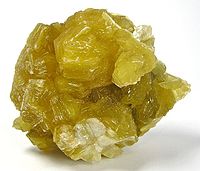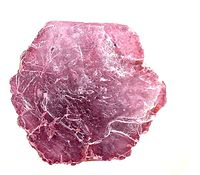Lepidolite
| Lepidolite | |
|---|---|
 | |
| General | |
| Category | Phyllosilicate |
| Formula (repeating unit) | K(Li,Al)3(Al,Si,Rb)4O10(F,OH)2 |
| Strunz classification | 9.EC.20 |
| Crystal system | Monoclinic |
| Crystal class | Prismatic (2/m) (same H-M symbol) |
| Space group | C2/m, Cm |
| Unit cell | a = 5.209(2) Å, b = 9.011(5) Å, c = 10.149(5) Å; β = 100:77(4)°; Z = 2 |
| Identification | |
| Color | Pink, light purple, purple, rose-red, violet-gray, yellowish, white, colorless other colors possible but are rare. |
| Crystal habit | Tabular to prismatic pseudohexagonal crystals, scaly aggregates and massive |
| Twinning | Rare, composition plane {001} |
| Cleavage | {001} perfect |
| Fracture | Uneven |
| Mohs scale hardness | 2.5–3 |
| Luster | Vitreous to pearly |
| Streak | White |
| Diaphaneity | Transparent to translucent |
| Specific gravity | 2.8–2.9 |
| Optical properties | Biaxial (-) |
| Refractive index | nα=1.525–1.548, nβ=1.551–1.58, nγ=1.554–1.586 |
| Birefringence | 0.0290–0.0380 |
| Pleochroism | X = almost colorless; Y = Z = pink, pale violet |
| 2V angle | 0° - 58° measured |
| References | [1][2] |
Lepidolite is a lilac-gray or rose-colored member of the mica group of minerals with chemical formula K(Li,Al)3(Al,Si,Rb)4O10(F,OH)2.[1][2] It is the most abundant lithium-bearing mineral[3] and is a secondary source of this metal. It is a phyllosilicate mineral[4] and a member of the polylithionite-trilithionite series.[5] Lepidolite is part of a three-part series consisting of polylithionite, lepidolite, and trilithionite. All three minerals share similar properties and are caused because of varying ratios of lithium and aluminum in their chemical formulas. The Li:Al ratio varies from 2:1 in polylithionite up to 1.5:1.5 in trilithionite.[6]
Lepidolite is found naturally in a variety of colors, mainly pink, purple, and red, but also gray and, rarely, yellow and colorless. Because lepidolite is a lithium-bearing mica, it is often wrongly assumed that lithium is what causes the pink hues that are so characteristic of this mineral. Instead, it is trace amounts of manganese that cause the pink, purple, and red colors.[7]
It is associated with other lithium-bearing minerals like spodumene in pegmatite bodies. It is one of the major sources of the rare alkali metals rubidium and caesium.[8] In 1861, Robert Bunsen and Gustav Kirchhoff extracted 150 kg (330 lb) of lepidolite and yielded a few grams of rubidium salts for analysis, and therefore discovered the new element rubidium.[9]
It occurs in granite pegmatites, in some high-temperature quartz veins, greisens and granites. Associated minerals include quartz, feldspar, spodumene, amblygonite, tourmaline, columbite, cassiterite, topaz and beryl.[1]
Notable occurrences include Brazil; Ural Mountains, Russia; California, United States; Tanco Mine, Bernic Lake, Manitoba, Canada; and Madagascar.

Yellow lepidolite from Itinga, Minas Gerais, Brazil. Size: 6.1 x 4.9 x 3.1 cm

Lavender lepidolite "books" from Himalaya Mine, Mesa Grande District, San Diego County, California, US. Size: 4.8 x 3.9 x 3.5 cm

Lepidolite, Virgem da Lapa, Minas Gerais, Brazil (size 2.4 x 2.1 x 0.7 cm)
References[]
| Wikimedia Commons has media related to Lepidolite. |
- ^ a b c Handbook of Mineralogy
- ^ a b Webmineral
- ^ Deer, W.A.; Howie, R.A.; Zussman, J. (1966). An Introduction to the Rock Forming Minerals. London: Longman. p. 218. ISBN 0-582-44210-9.
- ^ Hurlbut, Cornelius S.; Klein, Cornelis (1985), Manual of Mineralogy, Wiley, (20th ed.) ISBN 0-471-80580-7
- ^ Lepidolite on Mindat.org
- ^ "Polylithionite-Trilithionite Series".
- ^ "Lepidolite: A lithium-rich mica mineral, often pink or purple".
- ^ H. Nechamkin, The Chemistry of the Elements, McGraw-Hill, New York, 1968.
- ^ G. Kirchhoff, R. Bunsen (1861). "Chemische Analyse durch Spectralbeobachtungen" (PDF). Annalen der Physik und Chemie. 189 (7): 337–381. Bibcode:1861AnP...189..337K. doi:10.1002/andp.18611890702.
- Phyllosilicates
- Lithium minerals
- Potassium minerals
- Aluminium minerals
- Monoclinic minerals
- Minerals in space group 8
- Minerals in space group 12
- Mica group
- Luminescent minerals
- Gemstones
- Rubidium compounds


